![]()
![]()
![]()
Use LEFT and RIGHT arrow keys to navigate between flashcards;
Use UP and DOWN arrow keys to flip the card;
H to show hint;
A reads text to speech;
77 Cards in this Set
- Front
- Back
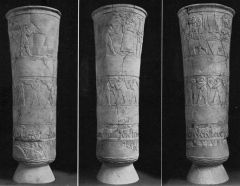
|
Warka Vase Uruk, moder Warka, Iraq ca 3200-3000 BCE Culture - Ancient Near Eastern Period - Sumerian |
|
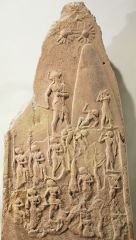
|
Victory Stele of Naram Sin found in Susa (Iran) pink sandstone 2254-2218 BCE Culture - Ancient Near Eastern Period - Akkadian |
|
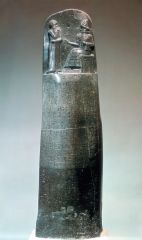
|
Stele with the Law Code of Hammurabi Susa Iran 1780 BCE basalt Culture - Ancient Near Eastern Period - Babylonian 282 laws
|
|
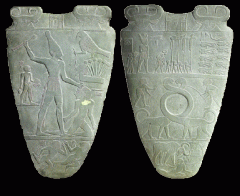
|
Palette of Narmer ca 3000-2920 kierakonpolis, egypt slate Culture - Ancient Egyptian Period - Predynastic
|
|
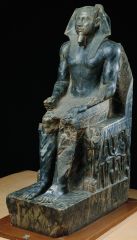
|
seated statue of Khafre from Gizeh ca 2520-2494 BCE ka statue Culture - Ancient Egyptian Period - Old Kingdom
|
|

|
Hypostyle Hall of the Temple of Amen-Re Karnak, Thebes ca 1290-1224 BCE sandstone Culture - Ancient Egyptian Period - New Kingdom, 19th dynasty |
|

|
Akhenaton temple of aton, Karnak, Thebes. sandstone ca 1353-1335 BCE Culture - Ancient Egyptian Period - New Kingdom, 18th dynasty |
|
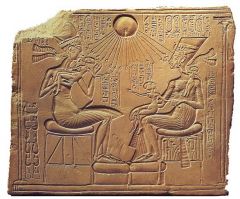
|
Relief of Akhenaten and his family (Nefertiti and 3 daughters) Amarna Limestone suken relief 1353-1335 BCE Culture - Ancient Egyptian Period - New Kingdom |
|
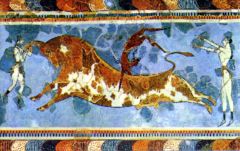
|
Palace at Knossos/frescos(bull Leaping) Knossos, Crete, Greece ca 1400-1370 BCE Culture - Ancient Greek Period - Minoan |
|

|
Lion gate Mycenea, Greece limestone relief panel ca 1300-1250 BCE -corbeled arch above the lintel forms relieving triangle Culture - Ancient Greek Period - Mycenaean |
|
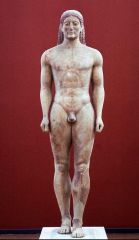
|
kroisos from anavysos Anavysos, Greece grave marker marble, 6'4" 530 BCE Culture - Ancient Greek Period - Archaic |
|
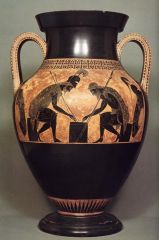
|
Ajax and Achilles play a dice game exekias Vulci, Italy black figure 540-530 BCE Culture - Ancient Greek Period - Archaic |
|
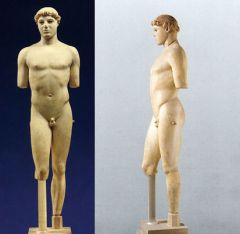
|
kritios boy from acropolis Athens, Greece marble ca 480 BCE contrapposto- weight shift Culture - Ancient Greek Period - Early Classical |
|
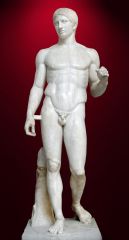
|
Doryphoros (spear bearer), the Canon Polykleitos marble copy of bronze original 450-440 BCE Culture - Ancient Greek Period - High classical |
|

|
Parthenon Iktinos and Kallikrates pericles restoration Athens, Greece pentelic marble 447-432 BCE Culture - Ancient Greek Period - High classical |
|
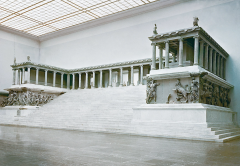
|
Altar of Zeus Pergamon, Turkey marble ca 175 BCE Culture - Ancient Greek Period - Hellenstic
|
|
|
composite view |
mixed perspective, side view and frontal view mixed together ex) egyptian art |
|
|
votive offering |
a religious offering from human to god in hopes that a prayer would be answered ex) statuettes from the square temple of Eshnanna |
|
|
hierarchy of scale |
unnatural manipulation of scale to show importance ex) Warka vase |
|
|
hypostyle hall |
a roof supported by columns |
|
|
kouros |
archaic greek statue of a naked young man ex) kouros from attica |
|
|
register |
Division of images into ordered tiers / horizontal bands leaving groups of images. |
|
|
Doric Temple: pediment |
low pitched gable, triangle shape that is formed between an entrance and a roof ex) E & W pediments of the Parthenon depicting the birth of Athena and the contest between posiedon and athena |
|
|
Doric Temple: metope |
space between tryglyphs in a doric frieze ex) relief picture between the three lines up at the top under the roof |
|
|
stele |
a carved stone slab erected to commemorate a historical event. ex) Stele of Naram Sin |
|
|
fresco |
wet-paint applied to wet plaster and becomes part of the wall. loose composition dry-painted on after dried, only in warm dry climate ex) leaping bull for wet fowling scene for dry |
|
|
ka |
concept of soul in ancient egypt. part of self that lives on after death |
|
|
Cella |
principal enclosed chamber of a classical temple. Also houses the cult stature in ancient Greek temples.
|
|
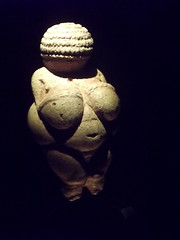
|
Nude woman "venus" from Willendorf Willendorf, Austria Ca. 28000-25000 BCE Limestone 4 1/2" high Crafted based on the given shape of the stone. Culture - Prehistoric Period - Paleolithic |
|
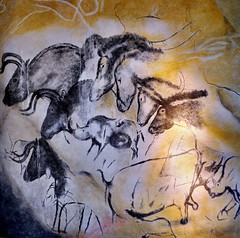
|
Cave Paintings in Chauvet Cave. Vallon-Pont-d'Arc, France 30,000-28,000 BCE Charcoal & ochre Details of Bisons, horses and rhinos Conceptual vs. Perceptual representation Culture - Prehistoric Period - Paleolithic |
|

|
Fowling Scene, from the tomb of Nebamun Thebes, Egypt 1400-1350 BCE Dry Fresco Scenes from a non-royal person. Described what the person would do in the afterlife. Culture - Ancient Egyptian Period - New Kingdom |
|
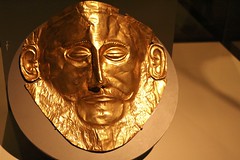
|
Funerary Mask (Mask of Agamemnon) Grave Circle A, Mycenae, Greece 1600-1500 BCE Gold repousse 1' high Culture - Ancient Greek Period - Mycenaean |
|

|
Aphrodite of Knidos Created by Praxiteles Roman Marble Copy based off of a Greek Original 350-340 BCE Pudica Pose (Pose of modesty) Culture - Ancient Greek Period - Late Classical Era |
|
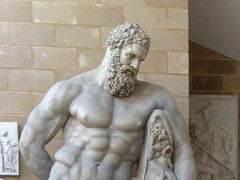
|
Weary Herakles (Farnese Herakles) Created by Lysippos Roman Marble copy of a Bronze original 320 BCE Fully aware of its physicality Exaggerated features to emphasize divine features Culture - Ancient Greek Period - Late Classical Era |
|

|
Battle Of Issues (Alexander Mosaic) Created by Philoxenos of Eretria 310 BCE Roman copy from original which was in Pompeii Italy, late 2nd or 1st Century BCE. Foreshortening used Culture - Ancient Greek Period - Hellenistic Era |
|

|
Dying Gaul Marble Roman Copy of a bronze original from Pergamon 230-220 BCE Culture - Ancient Greek Period - Hellenistic Era |
|
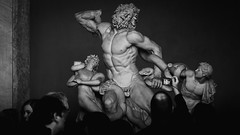
|
Laocoon and his sons Created by Athanadoros, Habesandros, and Polydoros of Rhodes Rome, Italy Early 1st Century CE Marble Culture - Ancient Greek Period - Hellenistic Era |
|
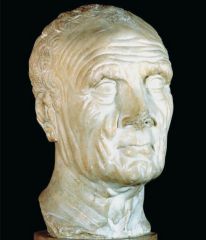
|
Head of an Old Man Osimo, Italy Mid-1st Century BCE Marble Veristic focus - focus on regular life rather than heroic or legendary figures. Form of realism Culture - Ancient Roman Period - Republic Era |
|
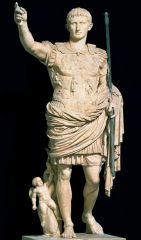
|
Portrait of Augustus as General (Augustus of Primaport) Early 1st Century CE copy of a bronze original of 20 BCE. Marble, 6' 8" Vatican Museums, Rome Cuirass depicts Divine lineage Culture - Ancient Roman Period - Early Empire Era |
|

|
Altar of Augustan Peace (Ara Pacis Augustae) Rome, Italy 13-9 BCE Dedicated to Pax, the Roman god of Peace Culture - Ancient Roman Period - Early Empire Era |
|
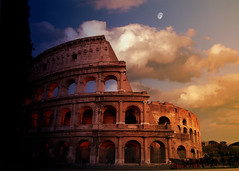
|
Colosseum (Flavian Ampitheater) Rome, Italy 70-80 CE Each level showcases a different Greek Architectural order: Tuscan, Ionic, Corinthian Culture - Ancient Roman Period - Early Empire Era |
|

|
The Column of Trajan Created by Apollodoros of Damascus Rome, Italy Dedicated 112 CE Column set on a base where the remains of Trajan and his wife remain in gold urns Sculpted the entire way up in a spiraling frieze Culture - Ancient Roman Period - High Empire Era |
|
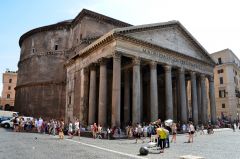
|
The Pantheon Rome, Italy 118-125 CE Combines a traditional classical front with a rotunda in the back Has an Oculus - A round or eyelike opening or design Culture - Ancient Roman Period - High Empire Era |
|
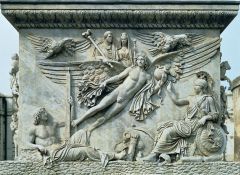
|
Apotheosis of Antoninus Pius and Faustina (Pedestal of the Column of Antoninus Pius) Rome, Italy 161 CE Apotheosis - The elevation of someone to divine status Culture - Ancient Roman Period - High Empire Era |
|

|
Portrait of Caracalla 211-217 CE Marble Looks suspicious and stern. A departure from the grandeur and divinity of previous emperors Culture - Ancient Roman Period - Late Empire Era |
|

|
Portraits of the four Tetrarchs Constantinople 305 CE, 4' 3" Made out of Porphyry - A purplish colored stone prized for its hardness and color. The color was associated with royalty. Culture - Ancient Roman Period - Late Empire Era |
|

|
Arch of Constantine Rome, Italy 312-315 CE Great example of Spolia - Repurposing former pieces of art into a new piece of art to pay homage to and show triumph over other nations Culture - Ancient Roman Period - Late Empire Era |
|
|
Parietal Representation |
Images on the interior of rock shelters and caves |
|
|
Cuneiform |
Form of writing which began around 3400-3200 BCE. Wedge-shaped characters derived from pictographs, and utilized in the ancient writing systems of Mesopotamia |
|
|
Iconoclasm |
Destruction or breaking of images |
|
|
Idealization |
The notion that art improves upon the natural / actual appearance of things |
|
|
Sunken Relief |
A relief where the artist cuts the design into the surface so that the highest projecting parts of the image are no higher than the surface itself |
|
|
Clerestory |
A raised section of a roof containing a series of windows, admitting light to the central parts of the building |
|
|
Corbelled Arch |
An arch formed by the piling of stone blocks in horizontal rows, cantilevered inward until the blocks meet |
|
|
Relieving Triangle |
The triangular opening above the lintel (which is a structural opening between two vertical supports) that serves to lighten the weight carried by the lintel itself. |
|
|
Kore |
Greek for "Young woman". An archaic Greek statue of a young woman |
|
|
Contrapposto |
The disposition of the body when one part is turned in opposition to another part, creating a counter-positioning of the body about its central axis. Provides a more naturalistic rendering of a human figure standing in space |
|
|
Red-Figured vase Painting |
The background of the vase would be filled in with a slip. The background would turn black and it allowed for greater possibilities than Black-Figured vase painting |
|
|
Black-Figure Vase Painting |
Figures and motifs were applied with a slip, which turned black during firing. The background remained the color of the clay. |
|
|
Doric Temple: Capital |
The distinct broader section / cap at the top of a column shaft or pillar |
|
|
Doric Temple: Triglyph |
A tablet with three vertical grooves placed in between the metopes |
|
|
Panatheniac Festival |
Festival celebrated every year with a sacrificial procession, and with a more splendid, Pan-hellenic festival (the Great Panathenaia), every four years. |
|
|
Continuous Frieze |
A long band of reliefs that is unbroken in terms of narrative, style, and subject matter |
|
|
'Wet Drapery' Figure |
A term used by art historians to describe diaphanous cloth that appears to cling to the body in animated folds while it reveals the contours of the form beneath |
|
|
Attribute |
A material object recognized as symbolic of a person, especially a conventional object used in art to identify a divine or mythical figure |
|
|
Pudica Pose |
A pose of modesty. Derived from 'pudenda' and equated with the words 'shame' and 'genitalia' |
|
|
Tesserae |
A small piece of stone, tile, glass, or other material typically cut to size and used in the construction of a mosaic |
|
|
Corinthian Order |
Characterized by construction of temples, palaces, and theaters. Conveys a further humanization of the gods. Exaggerated sculpted form |
|
|
Foreshortening |
The use of perspective to represent in art the apparent visual contradiction of an object that extends back in space at an angle perpendicular to the plane of sight |
|
|
Veristic |
The preference of everyday subject matter rather than heroic or legendary |
|
|
Concrete |
Building material invented by the Romans consisting of a combination of lime mortar, volcanic sand, water, and small stones |
|
|
Coffer |
A recessed panel in a ceiling, typically square in shape |
|
|
Apotheosis |
The elevation of someone to divine status |
|
|
Decursio |
Ritual circling of a Roman funerary pyre |
|
|
Tetrarchy |
Rule by four people |
|
|
Porphyry |
A purplish colored stone prized for its hardness and color. The color was associated with royalty |
|
|
Spolia |
The re-purposing of building stone for new construction, or the reuseof decorative sculpture on new monuments. |

